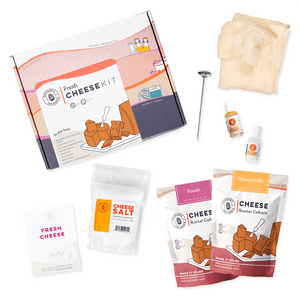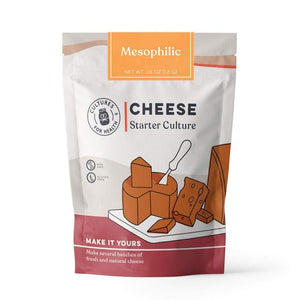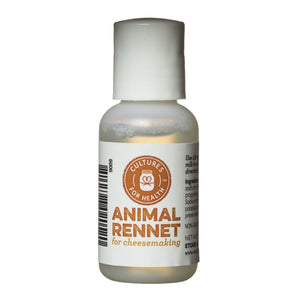
Haloumi is a hard cheese of Greek origin. It does well in hot weather, as the salt on the surface of the cheese from brining helps to inhibit the growth of bad bacteria and unwanted molds.
20 minutes
180 minutes
4
INGREDIENTS AND EQUIPMENT AVAILABLE AT CULTURES FOR HEALTH
Fresh Cheese Making Kit

Fresh Cheese Making Kit
$45.99
Our most comprehensive choice, the Fresh Cheese Kit contains two starter cultures and supplies to make five different varieties of soft cheese - feta, cottage cheese, cream cheese, fromage blanc, and traditional quark. Kit contains a Mesophilic Cheese Culture, a Fresh Cheese Culture, calcium chloride, vegetable rennet, cheese salt, butter muslin, a thermometer, and an instruction and recipe card.
Packaging and Equipment in the kit may appear different than pictured.
Mesophilic Direct-Set Starter Culture

Mesophilic Direct-Set Starter Culture
$19.99
From cheddar, Colby, and Monterey Jack to Feta, Chevre, and more, you'll enjoy the flavor and variety of homemade cheeses made using this starter culture.
Liquid Animal Rennet

Liquid Animal Rennet
$12.99
High quality single strength animal rennet. This non-GMO animal rennet is preferred for aged cheese as it creates a more desirable flavor and aroma during the aging process. Each bottle contains enough rennet to set (12) 2-gallon batches of cheese.
Cheese Salt

INGREDIENTS:
- 2 gallons whole milk
- 1 packet mesophilic culture
- 1/2 tsp. liquid rennet, diluted in 1/4 cup cool water
- Cheese salt
- 1 gallon cold water
INSTRUCTIONS:
- Slowly heat the milk to 86°F over low heat.
- Add starter culture and mix in well.
- Add the diluted rennet to the milk. Incorporate the rennet using slow, steady up-and-down motions. Stir in this manner for one minute, a bit longer if you are using farm-fresh cow milk.
- Cover and let the milk ripen for 30-45 minutes, undisturbed.
- Once there is a clean break, cut the curds into 1/2-inch cubes.
- Bring the temperature up slowly, at the rate of 2°F every 5 minutes, until the curds and whey reach 104°F. Stir gently while heating, to keep the curds from sticking together (matting). Once the milk has reached 104°F, maintain that temperature for 20 minutes, continuing to stir gently every few minutes.
- Line a colander with clean cheesecloth, and place it in a large bowl. Spoon the warm curds from the pot into the colander, draining until the flow of whey slows. Save all drained whey and the remains in the pot.
- Pack the drained curds into a 2-pound cheese mold lined with clean cheesecloth. Press cheese at 10 pounds of pressure for 3 hours. Pull the cheese out of the mold and peel away the cheesecloth. Flip the cheese over and re-dress it with the cheesecloth. Place it back into the mold and press again at 10 pounds for 3 hours.
- Heat the reserved whey to 190°F. Maintain the temperature. Place the pressed cheese in the hot whey and cook it for 30 to 35 minutes or until it has shrunken a bit and floats in the whey.
- Carefully remove the cheese from the whey and place it on a rack to cool for about 45 minutes, or until it is dry and cool to the touch.
- Make a medium-heavy brine (about 28-ounces of salt in 1 gallon of water), and chill it to 55°F. Place the dried cheese in a large plastic bowl and pour the chilled brine over it until the cheese is completely covered. If cheese floats, weigh it down with something clean and sterile and heavy.
- Store the cheese in the brine in the refrigerator for 5-10 days.
- Remove cheese from brine and wrap it in cheese paper. It will keep in the refrigerator for up to 2 months in this manner.
- Cheese can be eaten from the time it is placed in the brine.
















